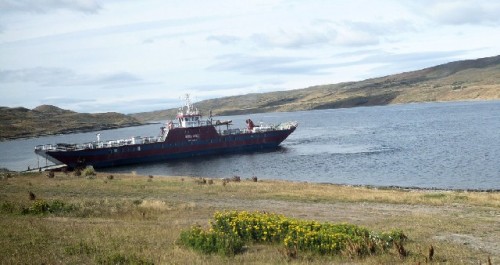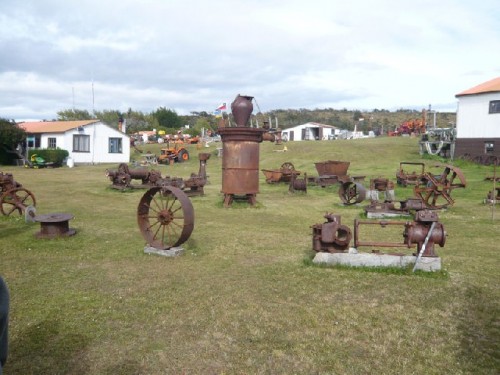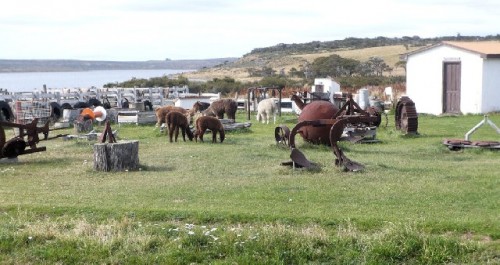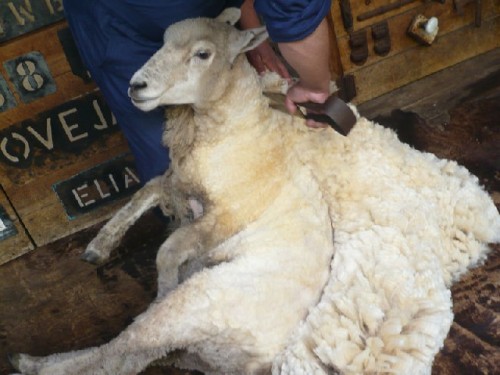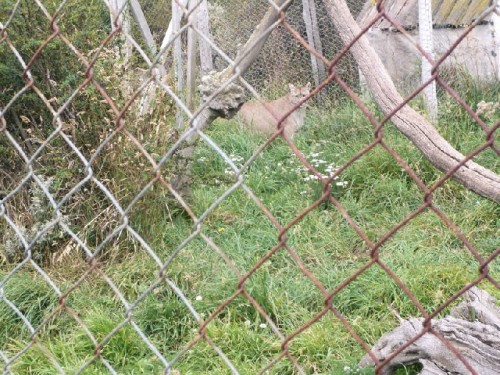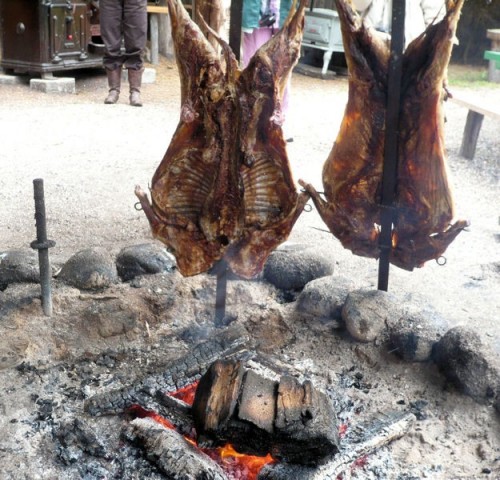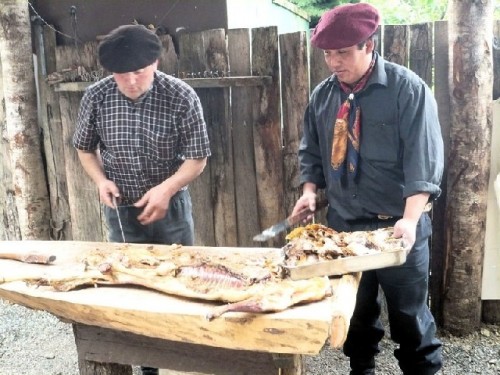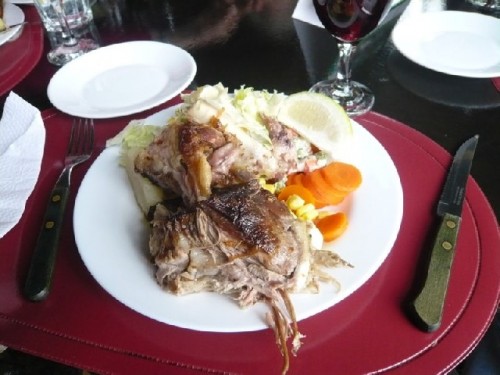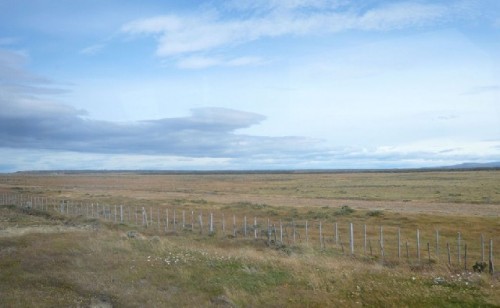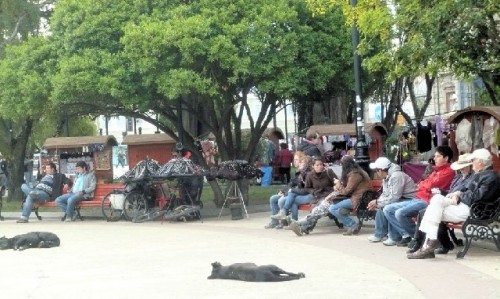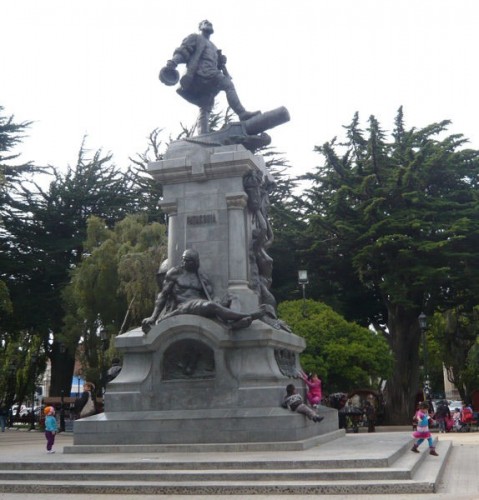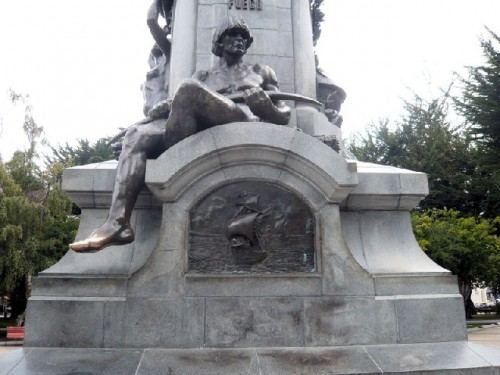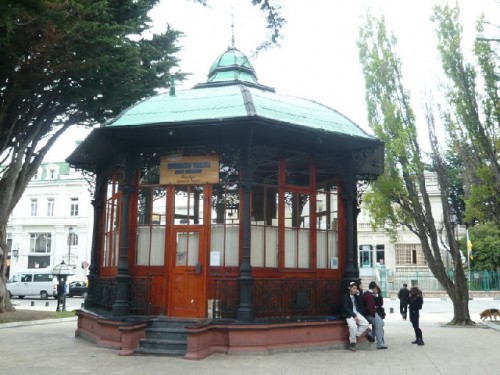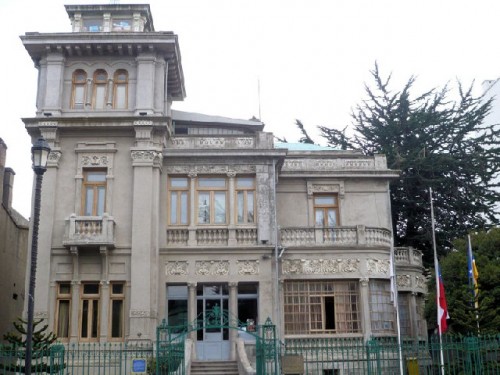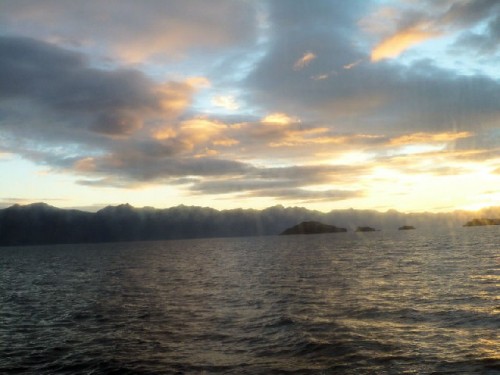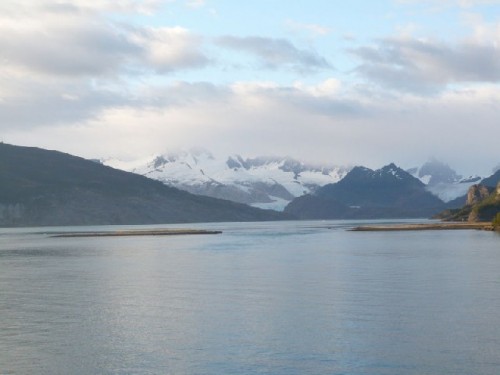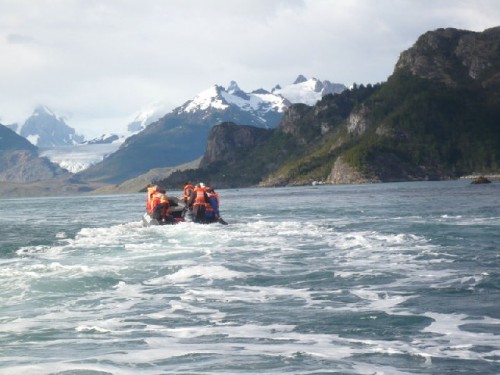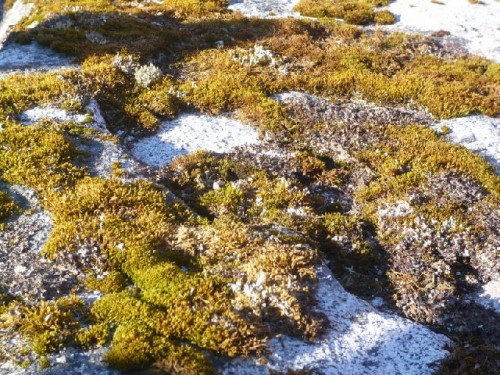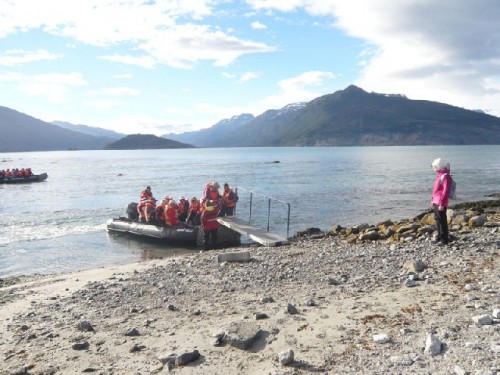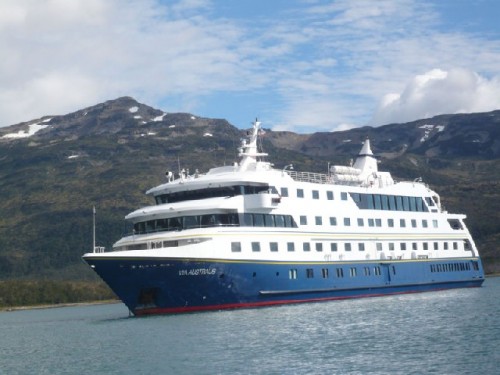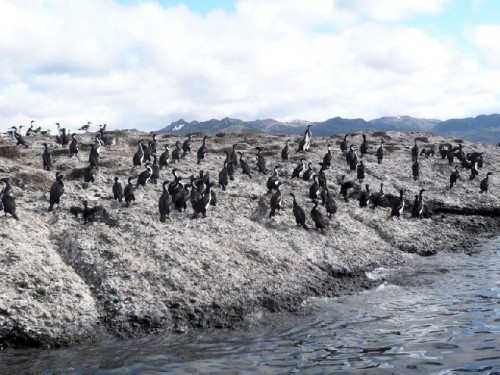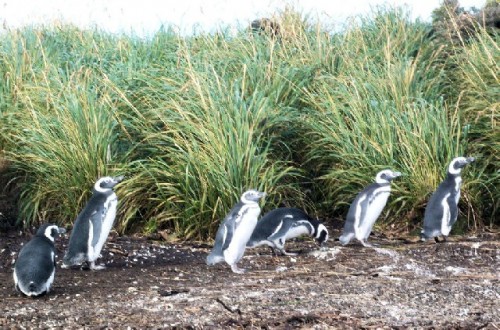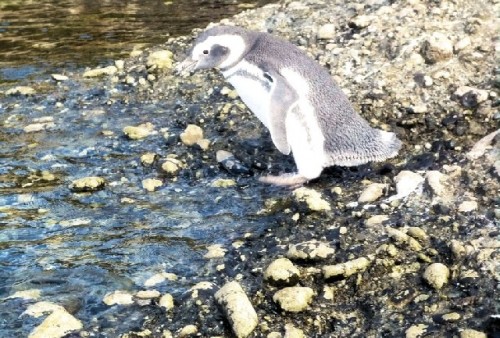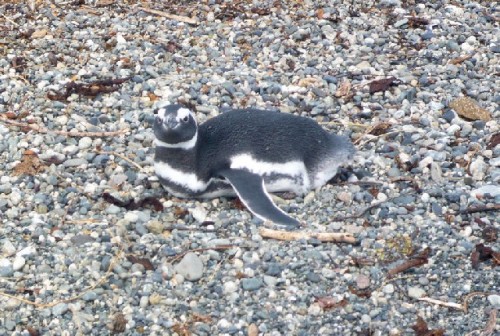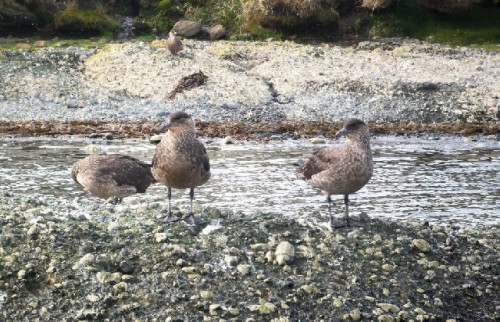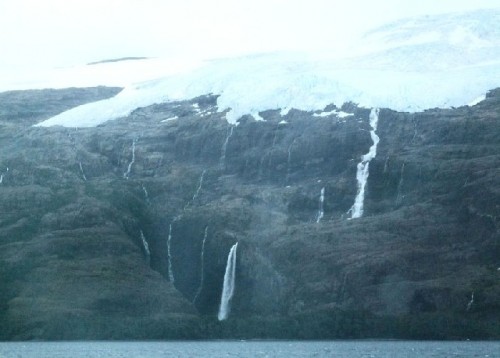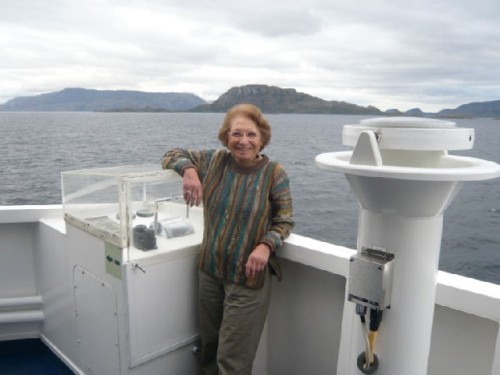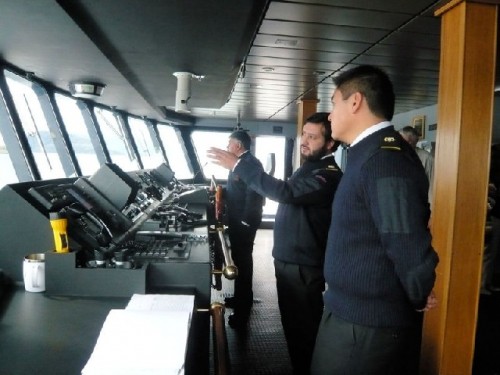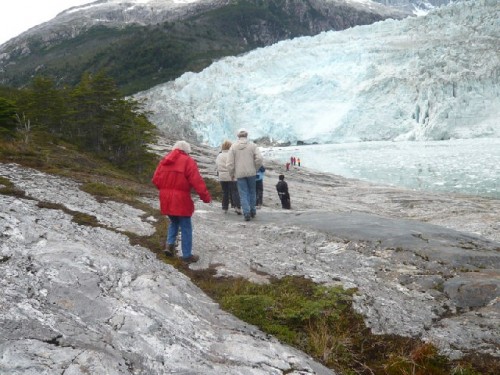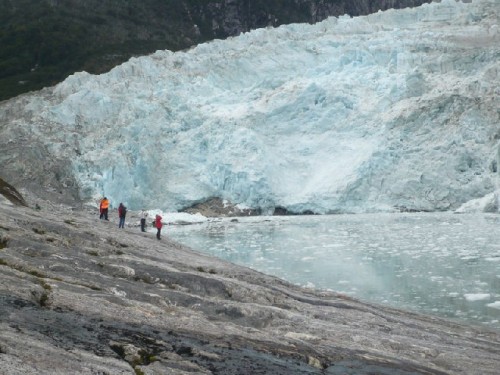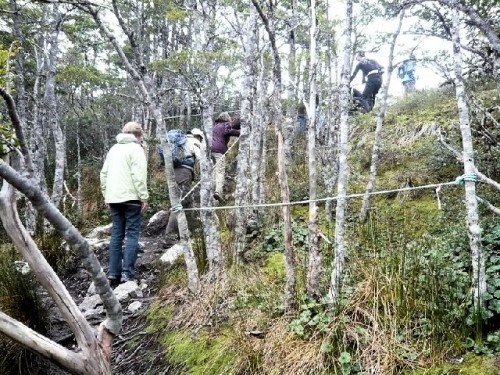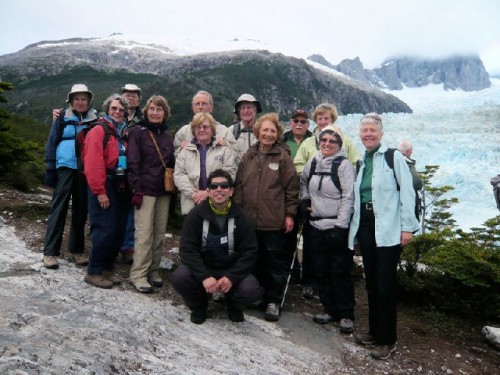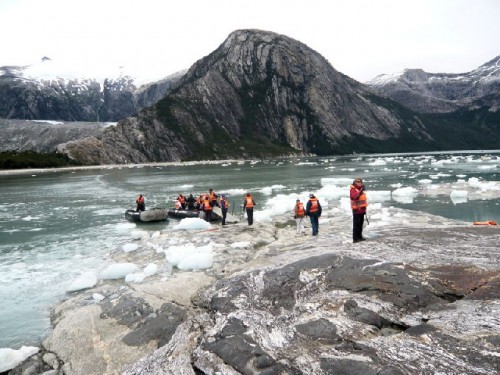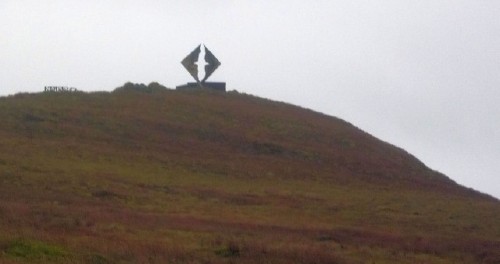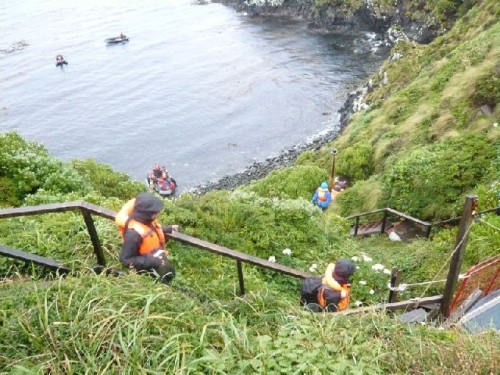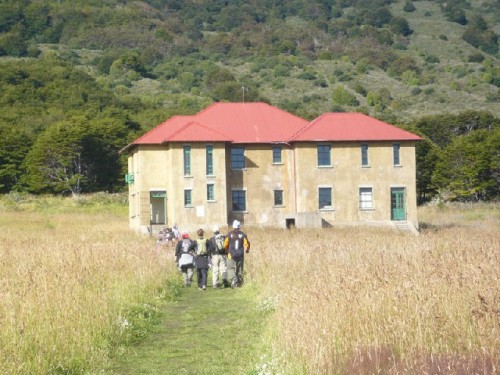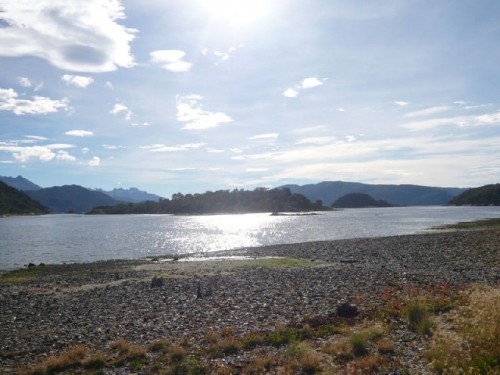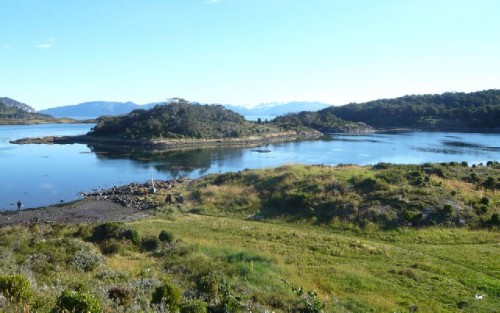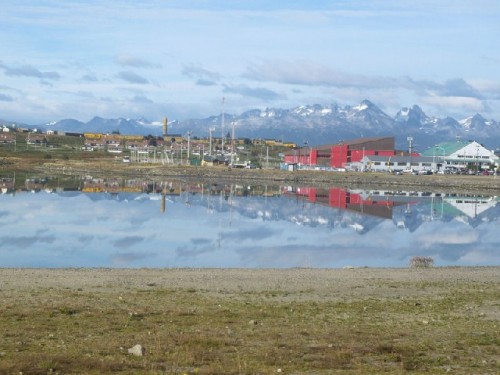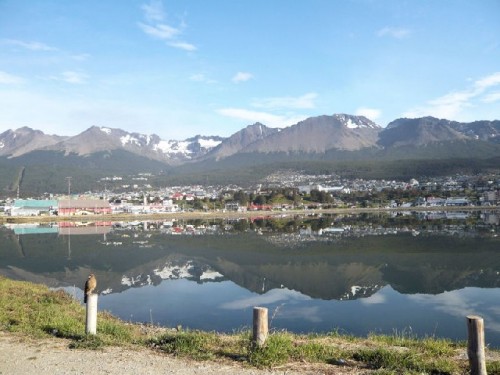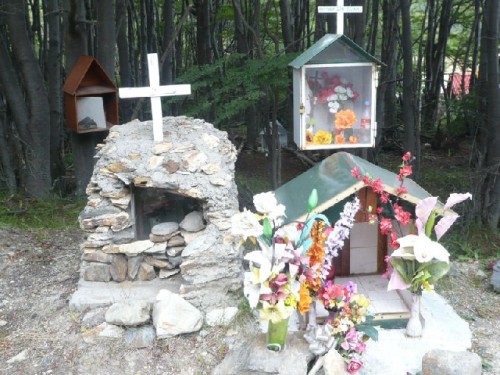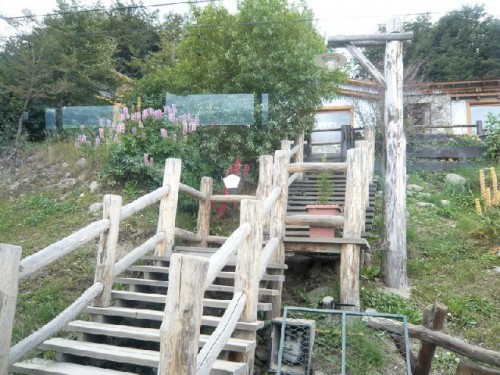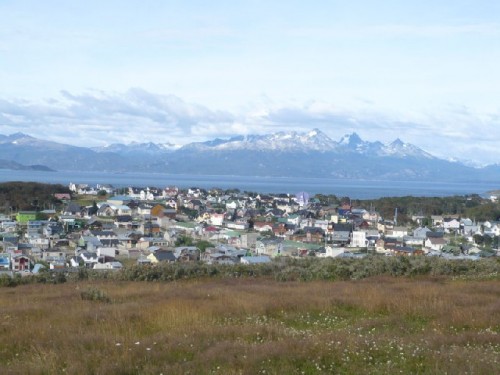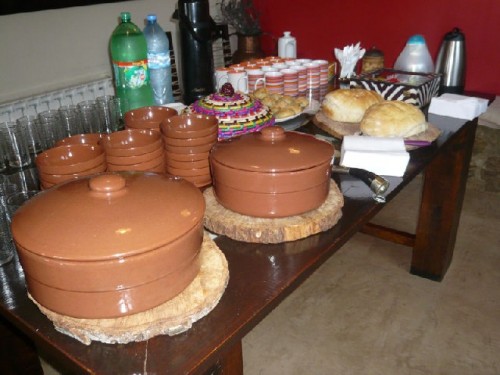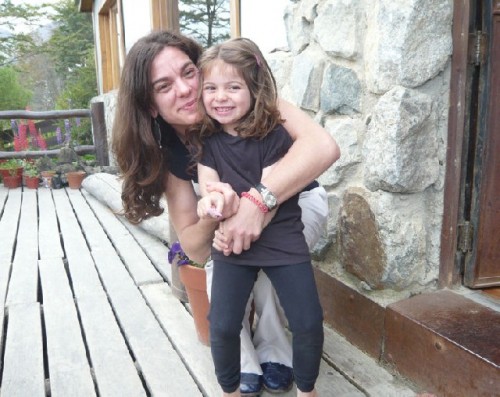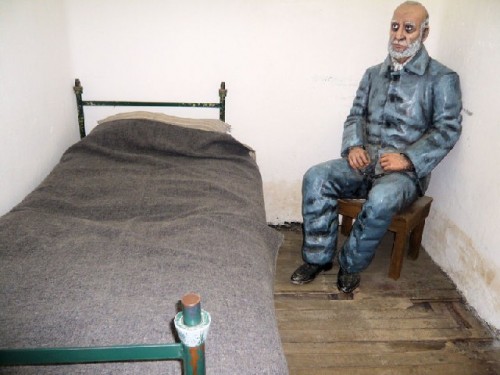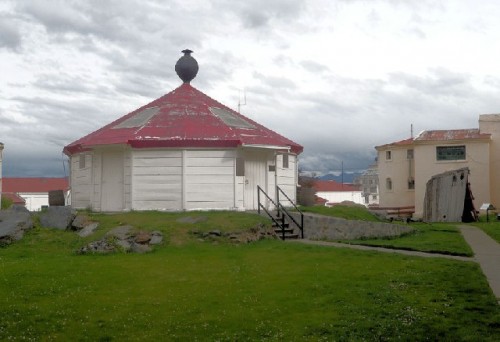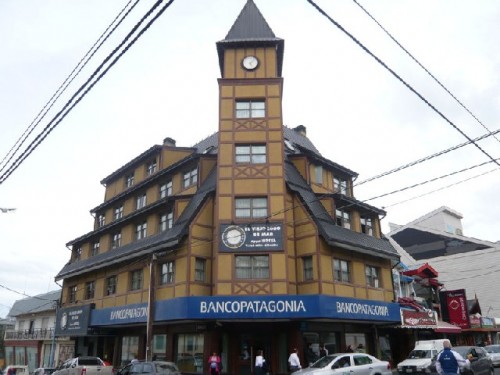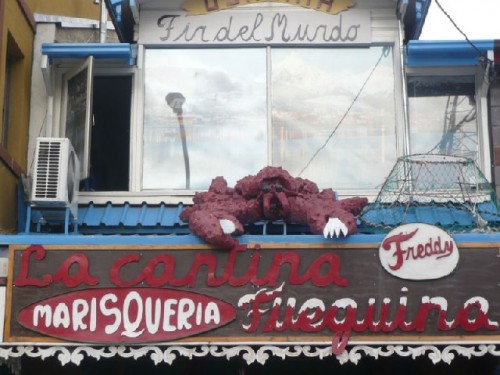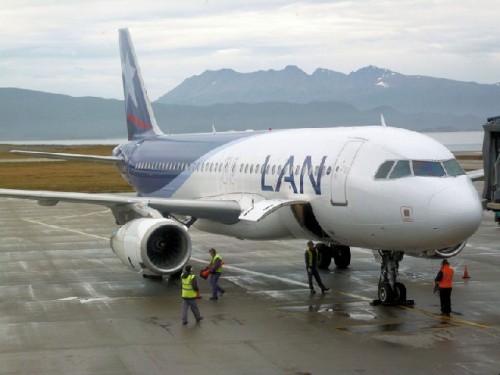Chile and Argentina: Part Three
Chilean Fjords, Tierra del Fuego and Cape Horn
By: Zeren Earls - Apr 18, 2013
After hiking the scenic trails of Torres del Paine National Park for a second day, we departed to continue our journey southward. We reached Puerto Natales, a charming seaside town, as the sun went down over shimmering waters. The Costaustralis Hotel welcomed us with a seafood dinner — ceviche, grilled salmon, rice, and calafate mousse for dessert, with pisco sour on the side.
In the morning we visited the Fitz Roy Ranch on the way to Puerto Arenas, the embarkation point for our four-day cruise of Chilean fjords and Tierra del Fuego. The ranch faces the eponymous canal and can be reached by car ferry. Upon landing we toured the grounds, part of which was an outdoor museum for antique farm tools; llamas grazed among the rusting equipment.
Our tour included watching sheep being bathed in a trough of water treated to rid their wool from ticks. Released from a corral one at time, the sheep were plunged into the water by ranch workers pressing on their backs with long-handled tools. Two people in our group assisted with this job. We also watched a shearer skillfully cut the sheep’s wool off in one piece. The wool is shipped to China, where it is used to manufacture wool blends. We also enjoyed seeing the ranch’s pet puma, kept behind a fence.
The ranch is a family business run by the daughter of a self-made man, who started out in life as a mail delivery boy. On the premises is a small Catholic church, constructed by the owner for his daughter’s wedding. Hand-made out of a variety of local wood with the bark intact, the interior of the rustic church spreads warmth, welcoming all.
Lunch was the highlight of the visit. Two whole lambs were roasted slowly over a wood fire. Salting before roasting makes the skin crisp. While the lamb was still on the spit, we got to slice and taste a piece — absolutely delicious because of the special grasses the lambs feed on in Patagonia. We enjoyed the lamb accompanied by carrots, potatoes, and a salad of lettuce, palm hearts, tomatoes, and cucumbers. Dessert was a choice of calafate berry or peach pie. Amaretto or mint liqueur topped the meal. At the shop I purchased a set of coasters made of colored horse hair; strung together, the set makes an attractive wall hanging.
Traveling southeast along vast plains, we reached Punta Arenas. This is a bustling port overlooking the Strait of Magellan, named after the explorer who first sailed the icy strait in 1520. We had two hours to discover this regional capital on our own. During this time, I walked through the central Plaza Muñoz Gamero, the focus of the city’s civic life. On this sunny day, people relaxed on park benches and vendors displayed their goods in tree-shaded stalls, while dogs slept nearby.
Children played around the Plaza’s main feature — an elaborate monument erected on the 400th anniversary of Magellan’s historic voyage. Magellan’s figure, embellished with a globe and a copy of his ship’s log, stands on a column, the facades of which stand for different symbolic figures — a native of the Selk’nam tribe representing Tierra del Fuego, a member of the Tehuelche tribe for Patagonia, and a mermaid with Chilean and regional coats of arms. According to local legend, anyone who touches the Tehuelche’s toe will return to Punta Arenas. Many crowded around the well-worn toe.
The Plaza and surrounding buildings constitute the city’s historic core. The architectural heritage includes a Victorian kiosk (1910), which now houses the municipal tourist office. Other historical sites are the elaborate mansions, built by wool barons following the introduction of sheep for breeding from the Falkland Islands in the late 19th century. My stroll on this calm day in Punta Arenas, otherwise known for its relentless gusts, was most enjoyable. Before departing for the pier, I picked up two local craft items — a small penguin and a ring, both made of lapis lazuli, Chile’s indigenous stone.
Finally on board the Via Australis, a cruise ship which was to be our home for the next four nights, we began our southernmost adventure in Patagonia around the channels and fjords that border the Tierra del Fuego archipelago. Over a welcome cocktail, we met the captain and his crew of 45 and received safety instructions. Among the ship’s 120 international passengers from Australia, Europe, Israel, Canada, and South America, our group of 23 was the only one from the US.
In the morning, I woke up to a dramatic sunrise outside the large window of our second-story cabin. With silhouetted mountains as a backdrop, sun streaked through the clouds, creating shimmers on the water’s surface. Excited, I rushed to the upper deck with my camera to record the spectacle. I viewed the scenery as the ship sailed through the Almirantazgo Inlet, approaching Ainsworth Bay, the site of the Marinelli Glacier. Donning our life vests, we left after breakfast in Zodiac boats for our first excursion. On shore we walked around beach rocks covered with lichen and moss, which grew denser inland, nurturing woods along cliffs with moisture retained from rainwater.
Our path crossed wreckage from beavers in the woods. Introduced from Canada for their fur, the beavers’ numbers have now reached some 100,000 since they have no predators, though their available diet in the southern climate produces poor-quality fur. Beavers are now being trapped to solve the problem. During a quiet time, we listened to the sounds of water trickling down from Magellan Peak. The distant sound of the water complemented the beauty surrounding us, as we walked by tidal inlets with small yellow flowers and flowering rushes, which were used by the natives to make fishing baskets in bygone days. Crunching mussel shells underfoot, we returned to the boats. Upon reaching the cruise ship, we had the bottoms of our shoes hosed down before we went in.
In the afternoon we continued cruising towards the Tucker Islets and were able to approach sea cliffs in our inflatable boats. Long-necked, heavy cormorants enjoyed resting on the rocks. Black cormorants with white chest plumage created a black-and-white tableau along the shoreline. A visit to a colony of Magellanic penguins was equally picturesque. Black when young, members of this species grow lighter in color with age and can be distinguished by the wide black stripes under their chins and horseshoe-shaped markings on their white stomachs. The flightless birds shuffled on flattened legs, looking for food at the water’s edge and blending in with the rocky terrain. On our way back, we spotted sea lions as well.
In the evening we learned about the native peoples of the region through a slide presentation. Nomadic hunter-gatherers, tribes such as the Kaweskar and Yamana settled in coastal areas and were sustained by marine life. They traveled by canoe, changing camp as needed. The Yamana wore no clothes, protecting their bodies with a layer of grease to help retain heat and repel moisture. They also used fire for warmth, hence the name Tierra del Fuego or “Land of Fire.”
The Selk’nam lived inland and lived by hunting guanaco and wearing guanaco skin. They made their huts out of stakes, sticks, and leather. When Europeans settled on the islands in the mid-19th century, they brought contagious diseases such as measles, smallpox, and tuberculosis; the latter killed half the Yamana population. Conflicts with ranchers over hunting sheep hastened the tribes’ extinction. There is only one pure Yamana living today.
Navigating the Whaler (Ballenero) Channel in the morning offered a breathtaking landscape as I viewed it from the bridge, where three men worked in four-hour shifts, never relying on an automatic pilot. It was reassuring that the captain was always present when navigating narrow channels.
The Chilean buffet lunch, by now an eagerly anticipated time of day, offered a variety of salads — ceviche, seaweed, mussels, octopus, green bean, boiled wheat, and beef liver. The main dishes included a selection of empanadas, king crab stew, fried fish, roast beef, corn stew, and pot pie with cornmeal crust. The desserts featured a variety of mousse, custard, cake, ice cream, and fruit.
After lunch we entered the majestic Pia Fjord and sailed toward the Pia Glacier through floating chunks of ice. Originating in the Darwin Mountain Range, the glacier meets the sea, doubled by its shadow on the water. Reaching the shore in Zodiac boats, we walked on granite terrain for a close view of the 6400 foot glacier. The varying density and moisture content of the ice mass creates a palette ranging from brown streaks to blue, depending on how much light penetrates the ice. Switching to a rocky path, we then climbed in single file for a panoramic view of the play of light and reflection; twelve of us, who made it to the top, celebrated the occasion with a group photo. Back at ground level we were treated to hot chocolate, whisky, or a combination of both.
Upon returning to our ship, we sailed along the northwestern arm of the Beagle Channel through Glacier Alley. Mountains capped with snow and ice, their peaks shrouded in clouds, lined both sides of the channel. We viewed one impressive glacier after another — the Romanche, Germany, France, Italy, and Holland Glaciers. As we passed by, we were surprised with music and a snack from the country each glacier was named after — Pavarotti arias, for example, as we snacked on bite-sized pizzas sailing along the Italy Glacier. In recent years these glaciers have been melting rapidly due to global warming, contributing to the rise in sea level. “Calving” glaciers release icebergs directly into the ocean and are sensitive to climate change once they lose their delicate equilibrium. Patagonia is the area of fastest glacial retreat on earth.
Navigating to Cape Horn, the southernmost point of the continent, where the Atlantic and Pacific Oceans meet, was a challenge. The wind has to be below 30 knots for safe landing; scouts went out to check and gave us their green light. Bouncing on choppy waters, we approached the Cape, which was enveloped in fog, wind, and rain. As we disembarked in a rocky cove, a wave splashed me, soaking my shoes. 160 steps took us 1400 feet up to the top, which was marked by a stylized seven-meter-high albatross, representing the southern seas. The steel monument commemorates sailors who lost their lives rounding the Horn. The lighthouse at the Cape has a small gift shop.
Our last Zodiac boat excursion was to historic Wulaia Bay, once the site of the region’s largest native settlements. We visited the information center, which has displays on the cultural and archeological heritage of the Yamana people, as well as about Darwin’s landing in1831 with the Beagle expedition. Wulaia, which means “beautiful” in Yamana, has diverse vegetation and landscapes. Some of us chose a shoreline walk over hiking for panoramic views. We strolled through ferns to a scenic point to appreciate the nature during another quiet time.
Over a farewell toast, the boat’s flag was raffled off. A couple in our group offered the highest bid in an auction for the navigation chart used on our journey. Having covered a total of 586 nautical miles, our cruise ended in Ushuaia, the world’s southernmost city. We disembarked at a busy port lined with big cruise ships, as Ushuaia is also a gateway to Antarctica. Near the port, a demonstration was being held against ships stopping at the Falkland Islands on their way to Ushuaia.
A city tour included a visit to the Veteran’s Lodge to hear Argentina’s perspective on the Falkland controversy. Two veterans with medals from the 1982 war with the UK explained Argentina’s claim to the Falklands (“Malvinas” in Spanish), an archipelago only 200 miles from the Argentinean coast and 8000 miles from London. The UK has colonized the Falklands since 1842, asserting rights to settlement since there were no natives living there when they arrived. The UN has left it to the two governments to settle the 175-year-old dispute. “We surrendered our troops, but not our territory,” said one veteran as we departed.
During a bus tour of Ushuaia, our guide, Berenice, explained the city’s apparent prosperity. A former penal colony for Argentina’s infamous criminals, Ushuaia is now both a tourist destination and home to many electronics industries as the result of an effort to populate the city, considered a hardship post due to the harsh climate. People who work here earn higher wages than in Buenos Aires. This “city at the end of the world” boasts a population of 70,000.
A visit to the house of a woman called Gabrielle on a hill with a view of the city and the snow capped Martial range provided a glimpse of prosperity. We reached the custom-built two-story contemporary house by a tiered stairway which led through a garden with flowers. The furnishings and objects on display spoke of world travelers with discerning taste. Their warm welcome, hospitality, and home-cooked meal set us on our way to further explore this beautiful city.
The charming shrines we had seen elsewhere during our trip seemed abundant in Ushuaia, where they lined mountain roads. Varying in size, the shrines appeared in hollowed rocks or specially constructed boxes. Raised in the Catholic faith, people have popular saints and healers, the most visited of whom is Gaucho Gil. People stop by the roadside to sprinkle water, light candles, and leave flowers or even hand-crocheted items. Pilgrimages are organized to seek miracles.
The Ushuaia Maritime Museum is a two-story building with pavilions dedicated to special collections. Life-sized dummies of infamous inmates occupy the cells of the Presidio, or Prison. The Maritime Pavilion has scale models of ships that have played a role in local history, such as Magellan’s galleon, the Trinidad, and the legendary Beagle. The Marine Art Pavilion provides an overview of the development of marine art, emphasizing works by local artists and depicting ports, vessels, and fishing expeditions. Argentina’s presence in Antarctica since the early 20th century is covered by materials in the Antarctic Museum. In addition, the museum complex has an art gallery and a full-size replica of a historic lighthouse on the grounds. There is too much here to see in a single visit; I found respite in the excellent book and souvenir shop.
During free time, I walked down Avenida San Martín, the city’s main commercial street, which was practically gridlocked with people from cruise ships. Business was brisk in shops and restaurants, especially those with large signs for crab, the region’s specialty. Arriving at the shoreline, I was struck by the streets rising to the north, some so steeply that they turned into staircases. The Artisan Market near the waterfront offered an opportunity to discover local artists at work. At small stalls, I bought an ink drawing of Antarctica signed by the artist and a picture depicting a country scene, made of a variety of indigenous wood.
Early in the morning, I left for the airport for the trip home via Buenos Aires, proudly packing the diploma I had received from our ship’s captain for reaching Cape Horn, the southernmost point of the world. On this rainy day my last photo, taken on the tarmac, was of silhouetted mountains defying the gray skies of incredible Patagonia.

